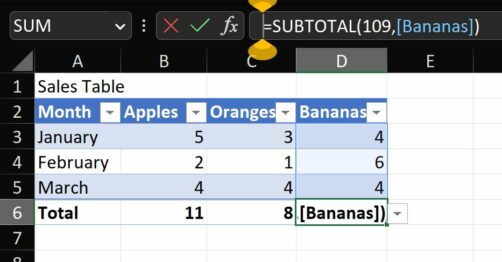It’s the third In-Process since NVDA 2023.1 came out, so we’re all out of new things from that version to talk about, right? ….. Not at all! Let’s go:
Table Headers in Excel
Back in February, we talked about Tables in Excel. At the time, we had recently introduced the ability to detect moving into or out of a table, when using UIA (NVDA 2022.4). User Interface Automation, or UIA provides performance and other benefits in Excel. One drawback currently, is that Microsoft haven’t yet enabled headers as NVDA uses them. With NVDA 2023.1, we have introduced a feature which partly helps with this. “Automatic reporting of column and row headers in tables”. This is referring to tables formatted via the “Table” button on the Insert pane of the Ribbon. “First Column” and “Header Row” in “Table Style Options” correspond to column and row headers respectively. The advantage of this method is that no action is required to setup table headers beyond creating the table in the first place. Tables also include visible headers for sighted users as well.

Table in Excel with sales for Jan – March for apples, oranges and bananas. The table has banded rows in blue, and the subtotal formula for the Bananas column is shows.
Landmarks on the web
Also in NVDA 2023.1 we have an improvement to landmark reporting. “A landmark or region’s name is always automatically spoken when jumping inside from outside using quick navigation or focus in browse mode.” Previously this wasn’t always automatically spoken.
But what is a landmark? Basically, a landmark is a way of labelling a section. A heading or button tells you what kind of control it is. A landmark can also tell the user a little about the content as well. For instance the “Navigation” landmark usually has the main navbar or table of contents. The “Main” landmark is usually where the main content of the page is. Pages can also have other landmarks – for instance Google has a “Search” landmark just before the main search edit. The NV Access site uses “Navigation”, “Main” and “Content info” landmarks. Content Info is a common landmark for the page footer information and links.
For any developers interested in learning more about Landmarks to use in your sites, W3Schools has some info.
New voices
We know many of our users love playing with voices. So, here are a couple we came across recently you might be interested in.
Firstly, Piper Neural voices. From the documentation:
Piper neural voices for NVDAThis add-on implements a speech synthesizer driver for NVDA using Piper.
Piper is a fast, local neural text to speech system that sounds great and is optimized for low-end devices such as the Raspberry Pi.
You can listen to voice samples here.
Piper is still in technical preview, but once it matures and stabilises, we’ll add it to the Extra Voices page.
The other voices we’ve come across recently which you can find on the the Extra Voices page are “Hear to read voices”.
Hear2Read is a group of volunteers who have developed TTS for 11 Indic languages plus English with Indian Accent, as listed below. These include Assamese, Gujarati, Hindi, Kannada, Malayalam, Marathi, Odia, Punjabi, Sanskrit, Tamil and Telugu. There is also an English with Indian Accent voice.
That’s all for this week. We’ll be back in a couple of weeks with more news and info.